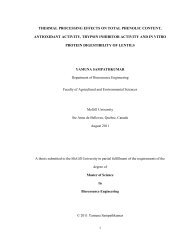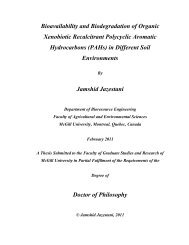foam-mat freeze drying of egg white and ... - McGill University
foam-mat freeze drying of egg white and ... - McGill University
foam-mat freeze drying of egg white and ... - McGill University
Create successful ePaper yourself
Turn your PDF publications into a flip-book with our unique Google optimized e-Paper software.
owl has higher stability than those made using another kind <strong>of</strong> bowl. This claim<br />
indicates the effect <strong>of</strong> copper on the stability <strong>of</strong> <strong>foam</strong> (Sagis et al. 2001). Similarly<br />
different kinds <strong>of</strong> stabilizers are used in stabilizing <strong>foam</strong>s <strong>and</strong> emulsions. Most <strong>of</strong> the<br />
stabilizers are high molecular polysaccharides in nature. Their hydrophobic nature<br />
prevents them from being absorbed at the plateau borders, this helps to strengthen bubble<br />
walls, which in turn helps to improve the stability <strong>of</strong> the <strong>foam</strong> (Papalamprou et al. 2005).<br />
Polysaccharides are more popular type <strong>of</strong> stabilizers than any other types (Baeza et al.<br />
2004). Proteins can also be used as stabilizers. For a protein to be a good stabilizing<br />
agent it should be able to reduce the surface energy levels between the bubbles as they<br />
are continuously created during <strong>foam</strong>ing (German & Phillips 1994).<br />
3.4.1 Xanthan Gum<br />
Xanthan gum is one <strong>of</strong> the widely used polysaccharide in food processing<br />
industries. Xanthomonas campestris pv. campestris produces Xanthan, which is<br />
exopolysaccharide in nature. Polyelectrolyte nature <strong>of</strong> the Xanthan molecule makes it<br />
highly water soluble. The temperature <strong>of</strong> the water does not affect the solubility <strong>of</strong><br />
Xanthan gum; this makes it highly adaptable for industrial applications regardless <strong>of</strong> the<br />
processing temperature (Becker et al. 1998).<br />
Xanthan Gum is one <strong>of</strong> the extensively researched food additives for its<br />
toxicological <strong>and</strong> safety properties. Laboratory tests at USDA on rats, showed no adverse<br />
effects such as toxicity <strong>and</strong> growth inhibition. Long term studies on rats <strong>and</strong> dogs also<br />
proved Xanthan gum produces no adverse effect (Kang & Pettitt 1993). United States<br />
Food <strong>and</strong> Drug Administration (FDA) approved Xanthan gum in 1969 as a food additive<br />
without any specific quantity limitations. In 1980 it got the European Commission (EC)<br />
17









